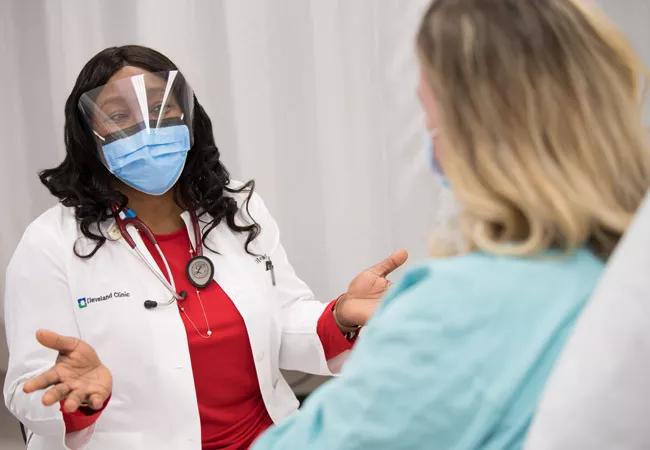False positives and inadequate follow-up care identified as major issues

After years of decline, syphilis cases are rising dramatically. According to the Centers for Disease Control and Prevention (CDC), the syphilis infection rate among females aged 15-44 has increased 171.9% since 2016, leading to a 291.1% increase in cases of congenital syphilis. This has serious consequences for infants. They are at increased risk of stillbirth, hydrops fetalis, low birth weight, cardiac and neurological defects, and preterm birth.
Advertisement
Cleveland Clinic is a non-profit academic medical center. Advertising on our site helps support our mission. We do not endorse non-Cleveland Clinic products or services. Policy
In Northeast Ohio, home of Cleveland Clinic, the syphilis infection rate since 2014 has jumped from 26.4 to 41.7 cases per 100,000 people, with an 82% rise in congenital syphilis from 2016 to 2021. This concerning trend led the Cleveland Clinic Ob/Gyn & Women’s Health Institute and Center for Pediatric Infectious Diseases to conduct a comprehensive, retrospective study of women who received perinatal care at the health system’s facilities from 2014 to 2021.
“It’s alarming to see a disease that should be trending down but is instead on the rise,” says Oluwatosin Goje, MD, a Cleveland Clinic obstetrician/gynecologist and Medical Director, Infant & Maternal Health Center. “This is the first rise in congenital syphilis in about 16 years. We analyzed our data to find out if we were doing everything possible to prevent it.”
Traditional syphilis screening starts with an initial nontreponemal test, such as the rapid plasma regain (RPR) test or Venereal Disease Research Laboratory (VDRL) test. If positive, they are followed by a confirmatory treponemal test. An alternative reverse-screening approach, which Cleveland Clinic adopted in 2014, starts with a treponemal test, such as the syphilis immunoglobin (Ig) G assay or a syphilis total IgM and IgG assay; if positive, this is followed by a nontreponemal test. If there are discordant results, a second treponemal test is administered. Additional testing is required to distinguish true positive (TP) and false positive (FP) results. In many populations, FP results are more common than TP results.
Advertisement
The study cohort included patients who had 75,056 pregnancies and 77,410 infants delivered from June 2014 through February 2021. Screening was initially recommended for all women at the first prenatal visit and, for high-risk women, again at the early third trimester and at delivery. Starting in July 2019, universal early third trimester rescreening was also recommended as part of the strategy to address the rise in congenital syphilis. The investigators were particularly interested in quantifying the frequency of noncompliance with recommended maternal and neonatal evaluation after an initial positive screen for syphilis.
Positive initial syphilis screens were documented for 221 women (183 FP and 38 TP), for an FP rate of 243.8 cases per 100,000 pregnancies and a TP rate of 50.6 cases per 100,000. Of the total screens, 46 used the traditional algorithm (38 FP and 8 TP) and 175 used the reverse algorithm (145 FP and 30 TP). The FP rate was .83 and was similar for traditional and reverse algorithms. “Sometimes providers may not know how to interpret results and need more information and reminders,” says Dr. Goje.
Of the women with true positive results, 21 (55%) had a past syphilis diagnosis (28 per 100,000) and 17 (45%) had a new diagnosis (22.6 per 100,000). Women with TP and FP screens had different characteristics. Those with TP screens were more likely to be Black, to use marijuana and to have non-syphilis sexually transmitted infections. This validates the need to rescreen patients at high risk for syphilis and other sexually transmitted infections in the third trimester or at delivery.
Advertisement
Few studies have examined the potential harms associated with syphilis screening during pregnancy, which include the time and expense associated with screening, and FP results that lead to stress, incorrect labeling and further diagnostic workup.
In this study, two women with false positive results and one infant received evaluations and treatments because of concern for syphilis. Two high-risk patients were not rescreened at delivery and were diagnosed after hospital discharge; one infant developed congenital syphilis.
Among 15 TP women with new syphilis, the diagnosis was before the late third trimester in 14. In half of these women, there was concern for reinfection, treatment failure, inadequate treatment or follow-up care or late treatment, and their infants did not achieve an optimal syphilis classification. “The findings reaffirm that we need to do rigorous testing and provide treatment when indicated,” says Dr. Goje.
In response to these findings, Cleveland Clinic updated its syphilis screening guidelines for those who are pregnant. The guidelines include:
Advertisement
“When in doubt, providers should reach out to the lab or infectious disease specialist to help interpret the results,” says Dr. Goje. “All pregnant patients should be offered universal testing at least twice during pregnancy to avoid missed opportunities for treatment.”
Advertisement
Advertisement

Screen patients seeking care for chlamydia, gonorrhea

Prescribing eye drops is complicated by unknown risk of fetotoxicity and lack of clinical evidence

ACOG-informed guidance considers mothers and babies

Psychological care can be a crucial component of medical treatment

Rare pregnancy complication can lead to fetal demise

Research may offer family-planning insights for those with the condition

Largest study examines factors affecting asthma exacerbations during and after pregnancy

Robust research focuses on detection and prevention